Discovering the Timeless Charm of Women's Ascot Ties
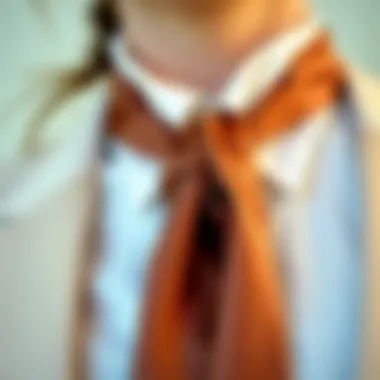
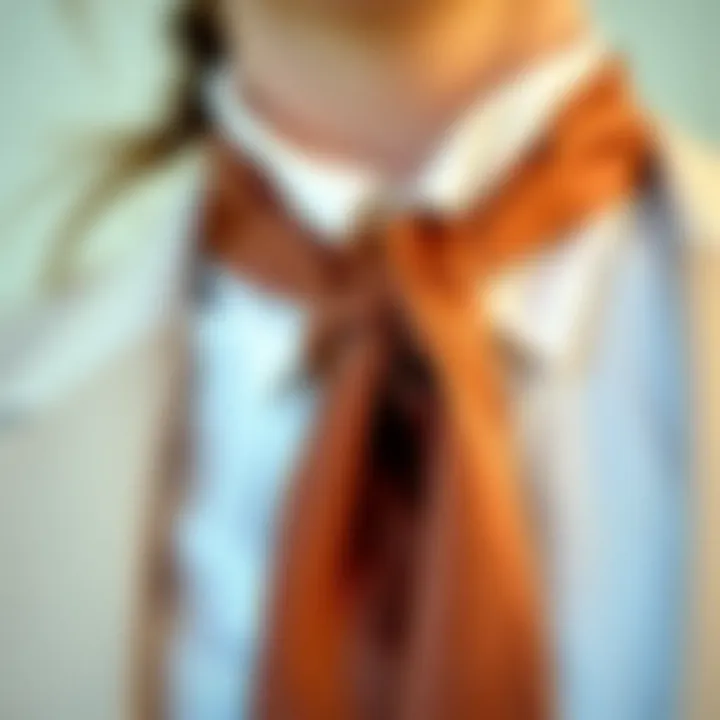
Intro
Ascot ties have long been regarded as a staple of equestrian chic and sartorial elegance. These sophisticated accessories, originally designed for men, have found their way into the realm of women's fashion, melding heritage with contemporary style. This article will take you on an exploration of women's ascot ties, revealing their rich backstory, styling nuances, and material selections that make them such a fascinating addition to any wardrobe.
Throughout the centuries, ascot ties have transformed from a formality reserved for the upper crust to a versatile accessory embraced by women from all walks of life. The simple act of tying a fabric elegantly around one's neck can elevate an outfit, create visual interest, and serve as an expressive statement. This piece is not merely about how to wear an ascot tie; it’s about understanding its cultural significance, how trends have shifted, and what styling choices are now available.
Whether you're dressing for a garden party, a day at the races, or even a casual brunch, these ties can be the cherry on top of any ensemble. We will also delve into tips for selecting the right ascot tie, its intricate knots, and how best to accessorize it to ensure all eyes are on you.
The Historical Context of Ascot Ties
The importance of understanding the historical context of ascot ties cannot be overstated. As an accessory that has bridged the gap between tradition and contemporary fashion, the ascot tie carries with it a story steeped in cultural significance and style evolution. Fashion enthusiasts and designers often look to this storied neckwear for inspiration, and knowing its origins offers valuable insights into how to incorporate it effectively into modern wardrobes. Examining its past is not only about appreciate the aesthetics but also acknowledging the craftsmanship that has defined it over the years.
Origins and Evolution of the Ascot Tie
The ascot tie finds its roots in the early 19th century, blossoming as a fashionable item among the British elite. It originally emerged from a formal event known as the Ascot Racecourse meetings held in Berkshire, where racing enthusiasts came dressed to impress. Back then, it was common for men to sport neckwear that made bold style statements, with the ascot tie becoming a popular choice due to its unique design.
Initially, ascots were crafted from silk and came in various color strata, often showcasing floral or paisley patterns. Over the decades, the ascot has undergone significant evolution. In the mid-20th century, the ascot tie began to adapt to changing fashion trends—slowly making its way into women's closets. The tie's wide blade and soft construction made it a comfortable addition to feminine attire, presenting women with the opportunity to express their individuality.
Ultimately, the ascot evolved into a versatile accessory, no longer reserved solely for official events or race days. Its evolution reflects broader changes in fashion, wherein traditional gender norms have shifted, allowing women to incorporate elements historically associated with men’s fashion into their style.
Cultural Significance in Fashion
In the world of fashion, ascot ties symbolize more than just a stylish accessory. They encapsulate the intersection of cultural identity and personal expression. Initially seen as clothing for the well-heeled, today, the ascot tie serves as a canvas for self-expression and creativity. It has made its way from the design rooms of high fashion into the hands of everyday wearers who sport it at casual gatherings, business meetings, and formal outings alike.
The ascot's role extends beyond mere appearance; it carries historical connotations of sophistication and class. Wearing one thoughtfully can evoke a sense of nostalgia for bygone eras, infusing modern clothes with a subtle nod to tradition. Furthermore, as it garners attention in places such as fashion shows and social media, the ascot continues to evolve, modified by various influencers and fashion-forward individuals.
"An ascot tie can transform an outfit, telling a story that transcends simple fabric and knots."
In examining the cultural significance of ascot ties within the larger realm of fashion, we recognize its relevance as a statement piece that reflects broader societal changes. Whether it's the vintage glam of a local gala or a daring ensemble at a contemporary fashion week, the ascot remains a staple, showcasing the elegance and versatility of women's fashion over the years.
As ascots continue to create waves in fashion cycles, understanding their historical context allows fashion enthusiasts, retailers, stylists, and designers to appreciate these ties not just for their aesthetic appeal but as an emblem of fashion’s ongoing narrative.
For further insights on the evolution of fashion accessories, you can explore additional academic resources: Encyclopedia Britannica and Wikipedia.
By tracing how these ties have woven themselves into the fabric of modern wardrobes, one can truly appreciate the elegance of ascot ties and their impact on personal style.
Design Variations of Women's Ascot Ties
Design variations in women's ascot ties are key to understanding their role in modern fashion. The diverse options available allow for personalized expression, while also honoring the accessory's historical roots. Ascot ties can capture an individual's style, whether it be classic elegance or a bold modern twist.
These variations are essential not only for aesthetic appeal but also for their functional adaptability. A well-chosen ascot can elevate an outfit while providing a refreshing point of interest. The subtleties in design, from fabric choice to knotting techniques, play a major role in how an outfit's story unfolds.
Classic Styles and Modern Interpretations
When considering ascot ties, one encounters a fascinating blend of classic styles and contemporary interpretations. The traditional ascot, often characterized by its wide shape and longer length, embodies a certain heritage, harking back to aristocratic events and formal gatherings. However, designers today are bending these characteristics in exciting ways.
For instance, contemporary versions might feature slimmer cuts or unique knots that give a nod to the past while pushing the envelope. The use of unexpected textures, such as crinkled fabrics or velvet, creates a visual rhythm that appeals to younger generations eager to mix the old with the new. Likewise, a silk ascot paired with tailored jackets or casual blouses can balance authority with femininity, making it highly versatile.
Patterns and Colors: Choosing the Right Look
The world of patterns and colors in ascot ties is rich and varied, providing ample opportunity for personal flair. When selecting an ascot, considering color theory alongside the intended outfit can be pivotal. For instance, a deep navy or burgundy can resonate sophistication, while bright florals or geometric patterns could express a playful spirit.
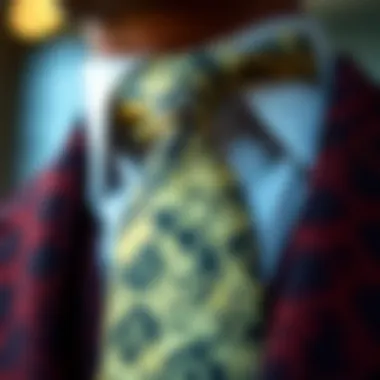
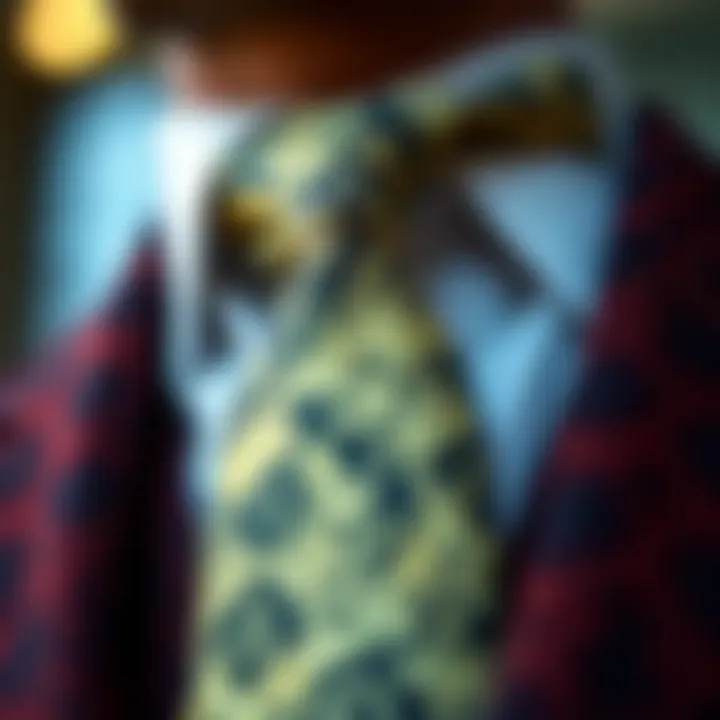
Patterns can also contribute to the overall mood of an outfit. Stripes may lend a chic, structured feel, whereas paisleys might convey free-spirited elegance.
Choosing the right look entails striking a balance between one's own preferences and current trends. Consider the occasion: deeper, muted colors may work well for formal events, while brighter hues can brighten a casual gathering. It’s all about striking the right chord, creating an ensemble that speaks not just about fashion, but also about the wearer's identity.
"Fashion is not about purchasing, it's about personal expression."
Fabric Choices and Their Impact
When considering the allure of women's ascot ties, the fabric in which these elegant accessories are made plays a vital role. The choice of fabric not only influences the visual appeal but also affects comfort, durability, and functionality. Understanding the attributes of different materials can be the deciding factor in selecting the perfect ascot tie for any occasion.
In the world of fashion, fabric is not merely a matter of aesthetics; it can dramatically alter the experience of both the wearer and the observer. For instance, a tie crafted from high-quality silk typically exudes an air of luxury and refinement. This makes silk ascot ties a favorable choice for formal events, where the glimmer of silk captures the light delightfully, highlighting the sophisticated designs. Conversely, wool ties often serve to bring a touch of warmth, making them ideal for cooler weather or settings that demand coziness alongside style.
Ultimately, the decision on fabric should align with various factors: personal comfort and style preferences, the type of outfit being worn, the occasion at hand, and even one's ethical stance regarding fabric production. The elegance of an ascot tie can very much hinge on these fabric choices, creating a unique and standout piece that aligns seamlessly with the wearer’s personality and the event’s context.
Silks versus Wools: An Overview
When juxtaposing silks and wools, one can uncover a fascinating contrast marked by texture, weight, and presentation.
- Silk offers a smooth, lustrous finish that is gentle against the skin. It's lightweight, which ensures that an ascot tie made from silk drapes elegantly around the neck. Moreover, the myriad of patterns that can be printed on silk makes it a versatile option, suitable for everything from high-stakes events to casual gatherings. The vibrant colors and intricate designs often associated with silk ties can enliven even the simplest of outfits.
- Wool, on the other hand, provides a more substantial feel. Known for its insulating properties, wool can be stunning during autumn and winter months. The texture of wool can vary, spanning from fine merino to a coarser finish, depending on the desired style. Subtle, earthy tones often characterize wool ascot ties, giving off a more understated elegance that harmonizes beautifully with textured materials like knits and heavier fabrics.
In terms of care, silk often requires more delicate handling and specific cleaning methods, while wool tends to be more robust and can usually withstand regular use with ease. The choice between these fabrics often comes down to personal style and the specific requirements of an outfit, emphasizing the impact fabric has on the overall presentation of an ascot tie.
Sustainable Fabrics and Ethical Choices
In today’s fashion industry, the conversation around sustainability is gaining increasing traction. When selecting an ascot tie, it’s worth considering not just the appearance but also the origins and ethical implications of the fabrics being used.
- Organic Cotton is becoming a popular alternative, known for being soft, breathable, and produced without harmful pesticides. Fashion enthusiasts may appreciate how an organic cotton ascot tie feels against the skin while also supporting sustainable farming practices.
- Tencel, made from sustainably sourced wood pulp, is another fabric gaining attention. It’s biodegradable and has a wonderfully soft drape, making it an appealing option for those looking to balance elegance with environmental consciousness.
Finding ascot ties that align with one’s values is not only rewarding but also enhances the overall experience of wearing the accessory. Choosing ethically produced fabrics proves that style doesn’t have to come at the cost of our planet. Incorporating these materials into wardrobes contributes not only to personal flair but also encourages a broader movement towards sustainability in fashion.
"The fabric of a tie can speak volumes about the wearer's style. Embracing sustainability elevates that message even higher."
By understanding the choices at hand, one can navigate the world of ascot ties more meaningfully, making informed decisions that reflect individual tastes and values. Utilizing quality fabrics, whether they be luxurious silks or eco-friendly alternatives, empowers the wearer to enhance their personal style while remaining conscious of their choices in today’s ever-evolving fashion landscape.
Styling Women's Ascot Ties
Styling women’s ascot ties is an art form that blends tradition with personal expression. It’s not just about wearing a piece of fabric around the neck; it’s about making a statement and enhancing an outfit with a touch of sophistication. Ascot ties are versatile accessories that reflect the wearer’s taste and individuality, and understanding how to style them effectively can elevate any wardrobe.
Pairing Ascot Ties with Different Outfits
When it comes to pairing ascot ties with various outfits, the possibilities are as broad as they are exciting. One important consideration is how the color and material of the tie complement an outfit. For instance, a bright, patterned silk ascot can add a pop of color to a simple black dress, creating a striking contrast. Alternatively, a more subdued, wool ascot can harmonize elegantly with earthy tones, like tan or olive green.
Here are some popular combinations:
- Casual Chic
Pair a light cotton ascot with a crisp white shirt and jeans for a relaxed yet refined look. A statement belt can further enhance this outfit. - Office Ready
A solid color ascot in a classic navy or burgundy can be worn over a tailored blazer. This adds a touch of personality while keeping a professional tone. Don’t shy away from mixes—floral prints can complement structured blouses quite well. - Formal Attire
For events like weddings or galas, opting for luxurious fabrics such as silk can truly stand out. Pairing a richly colored ascot with a flowing evening gown creates an air of elegance. It’s all about adding layers of sophistication without overwhelming the outfit.
One must keep in mind the overall look. An ascot tie can draw attention, so balance is key. A busy outfit can sometimes clash with a loud ascot, while something too simple may render the tie ineffective. Always consider the proportions and design elements involved to create a seamless look.
Occasions for Wearing an Ascot Tie
There are myriad settings in which an ascot tie shines brightly, showcasing its flexibility as an accessory. In the realm of fashion, knowing when to don an ascot can significantly influence one’s appeal.
“The true elegance of fashion lies not just in what you wear, but how and when you wear it.”


Common occasions for ascot ties include:
- Horse Racing Events
Such as Royal Ascot, where ladies sport fashionable outfits, often elevating their looks with beautifully styled ties. It’s a testament to tradition while also offering room for personal flair. - Weddings
Perfect for outdoor and garden weddings, an ascot tie makes for a sophisticated accessory that can match floral prints or wedding colors splendidly. - Brunch or Afternoon Gatherings
A stylish ascot adds charm to brunch ensembles, allowing wearers to step up their game beyond casual wear. Consider fabric and pattern choices that are in tune with the relaxed yet stylish ambiance.
Accessorizing with Ascot Ties
Accessorizing with ascot ties is an essential element in achieving a polished and sophisticated look. This article examines the role these ties play in enhancing an outfit while also emphasizing individuality and personal style. The versatility of ascot ties allows them to complement various ensembles, making them a go-to choice for fashion enthusiasts and those in the styling profession.
Complementing Jewelry and Other Accessories
When it comes to accessorizing with an ascot tie, the right jewelry can elevate one’s outfit significantly. Choosing pieces that harmonize with the tie's design is crucial for a cohesive appearance.
- Color Coordination: Select jewelry that shares at least one color with your ascot tie. For example, a pastel pink tie pairs beautifully with rose gold or soft pearl earrings.
- Material Balance: If the tie is made of a luxurious silk, consider wearing delicate gold or silver jewelry to maintain an upscale feel. Wooden or beaded accessories may seem out of place.
- Scaling: Keep in mind the scale of your accessories. A modest ascot tie won't shine against oversized statement pieces, while intricate jewelry can get lost with a more elaborate pattern on the tie.
A strategic approach to blending these elements can make an outfit truly memorable, providing a polished and thoughtful presentation.
Layering Techniques for a Chic Look
Layering is another art form when it comes to wearing ascot ties. It not only improves the overall aesthetics but also allows for adaptability to various styles. Here are several techniques:
- Under a Blazer: Placing an ascot tie beneath a fitted blazer can create an unexpected yet elegant touch. Open up the blazer just enough to let the tie peek through, adding an air of casual sophistication.
- Turtleneck Combo: For a chic winter layout, wear the ascot over a turtleneck. It softens the neckline and creates an impressive or stylish focal point.
- Adding Scarves: Incorporating scarves into your accessory mix can create depth. A light scarf can be draped casually over your shoulders while the ascot tie remains snug around your neck.
"With layering, you can play with textures, lengths, and styles—making each outfit distinctively yours."
Practical Tips for Choosing an Ascot Tie
Choosing the right ascot tie is both an art and a science. For fashion enthusiasts, stylists, and anyone wanting to elevate their look, understanding the practical aspects behind selecting an ascot tie can make a world of difference. These sophisticated accessories don’t just add flair; they also create a balanced visual that can enhance an outfit's overall elegance. Since ascot ties are often worn at special occasions like weddings or formal events, knowing how to choose one that suits the occasion and the wearer is essential.
Identifying the Right Length and Width
Finding the right length and width for an ascot tie is crucial for achieving the desired look. Generally, an ascot tie should hang elegantly, not too short to appear awkward, and not too long that it crumples at the waist. A good rule of thumb is that the narrow end of the tie should ideally reach just above the waistline.
The width can vary based on personal style and outfit coordination. A wider tie will often make a bolder statement, while a slimmer version may contribute to a more traditional vibe. When choosing these dimensions, consider:
- Face Shape: Different face shapes may pair better with wider or narrower ties. For instance, individuals with more angular faces may lean toward wider styles, whereas rounder faces might benefit from narrow designs.
- Body Proportions: Your body type plays a big role. Taller individuals may pull off wider ties better, which can create balance. Conversely, shorter frames often suit narrower types.
- Outfit Compatibility: Take the entire ensemble into account. Is the dress more detailed? A narrower ascot might complement it without overwhelming the look.
Considerations for Comfort and Fit
An ascot tie is not just about looks; it’s also vital that it feels right when worn. A comfortable fit means that it hangs elegantly without pinching or tugging. Here are some pointers to ensure comfort:
- Material Matters: The fabric can greatly affect comfort. Silk, for example, is smooth and breathable, while heavier fabrics might feel restrictive in warm weather. If you know you’ll be in a warm environment, opt for lightweight fabrics.
- Adjustability: Many ascot ties come with adjustable features. This allows for customized fitting, accommodating different neck sizes and styles of wearing the tie.
- Practice Tying: If you're unfamiliar with tying an ascot, it’s worth practicing ahead of time. A well-tied ascot not only looks polished but also feels secure, making it easier to carry yourself confidently throughout the day.
"In fashion, comfort should never take a backseat to style; they should go hand-in-hand, creating a harmony that the eye appreciates and the body enjoys."
Selecting the perfect ascot tie may seem daunting at first, but taking these practical tips into account can simplify the process. When you focus on length, width, and comfort, you’ll be on your way to adding a stylish statement piece that reflects your unique fashion sense, ensuring that you wear your ascot tie with confidence.
Contemporary Trends in Women's Ascot Ties
In recent years, women's ascot ties have undergone a significant transformation in terms of style, utility, and perception. These captivating accessories are no longer viewed solely as relics of historic race events but have reshaped their identity within modern fashion. This evolution signifies more than mere aesthetics; it embodies a lifestyle choice that embraces both tradition and contemporary flair. In this section, we will explore the trends that shape today's ascot ties, emphasizing their rising importance in a variety of fashion contexts.
Fashion trends often echo the sentiments of society, and ascot ties are no exception. As more women seek versatile and statement-making accessories, designers have responded by crafting ties that cater to various lifestyles while maintaining a nod to the past. This includes playful designs that break away from conventional norms, utilizing a wide array of colors and patterns. Whether it's floral prints that evoke a sense of spring or geometric shapes that beckon to urban sophistication, these modern takes contribute to the versatility of the ascot tie.
Fashion Influences and Iconic Wearers
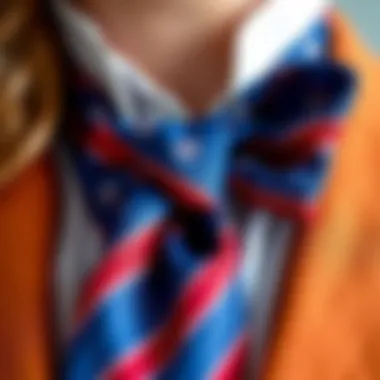
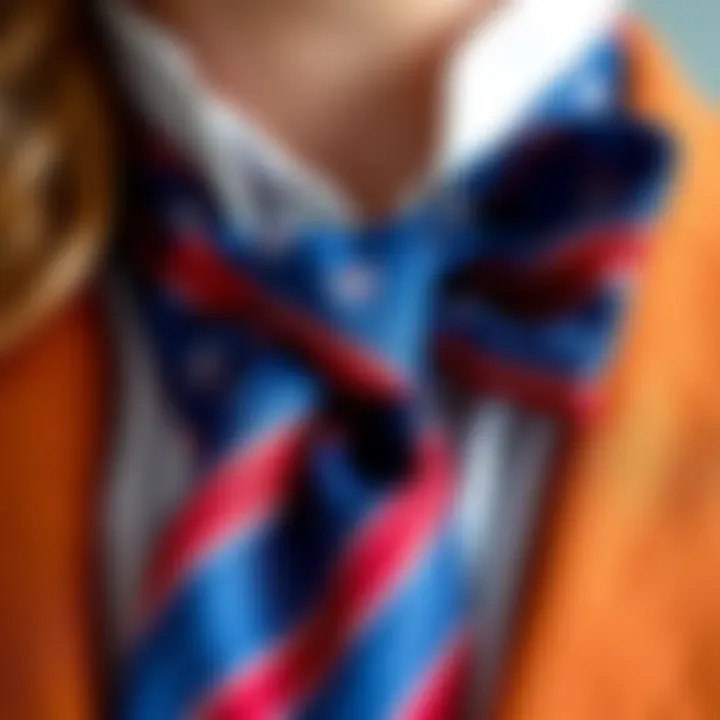
The resurgence of ascot ties is closely tied to cultural icons who have embraced this accessory. High-profile celebrities, fashion bloggers, and even members of royalty have integrated ascot ties seamlessly into their wardrobes, showcasing their adaptability. The likes of Kate Middleton and Amal Clooney have been spotted sporting ascent ties at various events, each time emphasizing their distinct styles. Their sartorial choices not only spark interest but also inspire countless admirers to explore wearing ascot ties with their own unique flair.
"Fashion is about something that comes from within you."
— Ralph Lauren.
The influence on ascot ties extends beyond individual who wears them. They have found their way onto the runways of renowned fashion houses, with designers incorporating them within their collections, often pairing them with unexpected clothing choices. For instance, wearing an ascot tie with an elegant evening gown or casual denim results in a harmonious blend of chic sophistication and playful rebellion.
Moreover, designers have created ties tailored for specific occasions, from casual outings to formal events. This adaptability invites discussions about personal expression through fashion.
The Role of Social Media in Popularizing Ascot Ties
Social media has played a pivotal role in the revival of women's ascot ties. Platforms like Instagram and Pinterest have become breeding grounds for fashion inspiration, allowing users to discover new ways of styling ties and witness how others incorporate them into their outfits. Visual storytelling through these platforms highlights not just the accessory itself but also the ways in which an ascot tie can define or elevate an ensemble.
Some fashion influencers dedicate entire posts to style guides, demonstrating various tying techniques, outfit pairings, and event appropriateness, which serves both to educate and inspire the audience. They often illustrate how age-old pieces like ascot ties can effortlessly transition from formal gatherings to relaxed brunches.
The hashtag #AscotTie has gained traction, flooding feeds with creative interpretations, thus introducing new fans to the accessory. This rapid sharing highlights aspirational fashion, where anyone, regardless of spontaneous thrift shop finds or high-end purchases, is encouraged to partake in the joys of styling their ascot ties with flair.
To sum up, the present-day trajectory of women's ascot ties showcases a fabric of history interwoven with innovation. As these ties gain momentum in the fashion world, both through star-studded endorsements and social media engagement, they solidify their stance as staples that can facilitate fashionable expression in the ever-evolving landscape of women's fashion. As we look forward, it will be fascinating to observe how these trends further develop and the new interpretations that emerge.
Caring for and Maintaining Ascot Ties
In the world of fashion, accessories are not just add-ons; they often define the character of an outfit. Women's ascot ties, with their unique blend of elegance and sophistication, require proper care and maintenance to keep them looking sharp and crisp. Understanding how to care for these ties elevates not just the accessory itself, but also the overall presentation. Regular attention to cleaning and proper storage contributes significantly to the longevity of ascot ties. After all, a well-maintained ascot can lie at the heart of a well-put-together wardrobe.
Cleaning and Storage Best Practices
Keeping ties clean is fundamental. Since ascot ties are often made from delicate fabrics like silk, the cleaning process needs to be gentle yet effective. Here are a few practical tips:
- Hand Washing: It’s best to wash your ascot ties by hand using cool water and a mild detergent to avoid damaging the fibers. Gently agitate in water; never wring them out as it can distort their shape.
- Drying: After washing, lay the tie flat on a clean, absorbent towel. Roll it gently to remove excess water, then hang it to dry away from direct sunlight. You don’t want the colors to fade and lose their richness.
- Storage: When it comes to storing, rolling the tie rather than folding it can help preserve its shape. Use a bespoke tie box or simply store it in a drawer, ensuring it’s not squished up against other items. This helps maintain its form and prevents unsightly creases.
Proper care not only enhances the durability of ascot ties but also reflects personal style and attention to detail.
Repairing Damaged Ties
Even with careful handling, accidents happen. Damaged ascot ties can be disheartening, but repair is often simpler than expected:
- Minor Stains: For small stains, a simple dab with a cotton swab soaked in a gentle stain remover can do wonders. Always test a small, inconspicuous area first to avoid further damage.
- Loose Threads: If the tie has loose threads, cutting them off can prevent further damage. For frayed edges, a professional tailor can help with serging or re-heming to restore its elegance.
- Professional Repair: For significant damage, such as tears or stains that won’t budge, consulting a specialized dry cleaner or a tailor is recommended. They have the expertise to handle delicate fabrics and can provide solutions that maintain the aesthetic of your ascot tie.
In summary, caring and maintaining ascot ties does require some effort, but the payoff in longevity and appearance is invaluable. Understanding the right cleaning techniques and repair methods can turn a simple ascot tie into a timeless accessory that will elevate any outfit for years to come.
Future Directions in Ascot Tie Fashion
The future of ascot ties in women’s fashion stands at an intriguing crossroads of tradition and innovation. As styles evolve, the ascot tie is not only retaining its place as a timeless accessory but is also adapting to new aesthetics and cultural movements. Understanding these future directions enhances appreciation for ascot ties and offers insight into how fashion mirrors societal changes. The growth of social media, coupled with a shifting emphasis on individuality, plays a pivotal role in shaping what ascot ties can represent for modern audiences.
Innovative Designs and Concepts
In recent years, the ascot tie has begun to venture beyond its classic silhouette. Designers are exploring fresh iterations, which breathe new life into this age-old accessory. Take for example the work of contemporary designers like Vivienne Westwood, who often infuses a rebellious spirit into traditional garments. This has led to ascot ties made from unusual materials, such as vegan leather or recycled fabric, challenging the status quo of fabric choices.
- Shape Alterations: One trend is varied shapes and sizes of the ascot, moving away from the standard long, narrow format. More asymmetrical designs have started capturing attention, providing an avant-garde edge to outfits.
- Use of Embellishments: Historically simple, the ascot tie is now adorned with embellishments like beads or intricate embroidery. This push toward customization resonates with a broader consumer preference for personalization, allowing wearers to showcase their unique style.
- Tech-Infused Fabrics: Some avant-garde fashion houses are venturing into tech-infused fabrics that can change color with temperature or offer moisture-wicking properties, redefining practicality in formal wear.
These innovative designs not only modernize the ascot tie but also challenge wearers to engage with their fashion choices in a deeper sense, stepping away from mere conformity toward expressing individuality.
The Growing Importance of Individuality in Style
In today's world, fashion is no longer solely about trends dictated by overarching styles; it's increasingly a vessel for personal expression. The ascot tie, with its rich history and potential for modern reinterpretation, fits perfectly into this narrative. As individuals become more conscious about their unique aesthetic, ascot ties offer a versatile option for showcasing individuality.
Social media platforms like Instagram and Pinterest have made it easier for fashion enthusiasts to share their unique styles and get inspired by others. This visibility fosters a culture where personal style takes precedence over uniform trends.
- Influencers and Personal Brands: As fashion influencers and everyday users showcase their ascot takes, they create diverse interpretations that appeal to different audiences, motivating others to explore this accessory in new ways.
- Custom and Handmade Offers: With the rise of platforms such as Etsy, buying unique, handmade ascots is becoming more common, emphasizing the need for distinctive personal touches in accessories.
"Fashion that reflects individuality is an unspoken statement—it's not merely about the clothes on your back but about the narrative you choose to tell the world."
As consumers gravitate towards items that reflect their inner selves, the ascot tie stands poised to evolve alongside this rising demand, embodying both history and personal flair. In the coming years, we’ll likely see a dynamic fusion of classic elements and novel originality emerge, ensuring that ascot ties remain not just relevant but also essential in a modern wardrobe.















